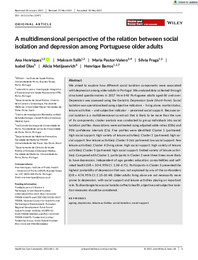Por favor, use este identificador para citar o enlazar este ítem:
https://hdl.handle.net/11000/30541Registro completo de metadatos
| Campo DC | Valor | Lengua/Idioma |
|---|---|---|
| dc.contributor.author | Henriques, Ana | - |
| dc.contributor.author | Talih, Makram | - |
| dc.contributor.author | Pastor-Valero, Maria | - |
| dc.contributor.author | Fraga, Sílvia | - |
| dc.contributor.author | Dias, Isabel | - |
| dc.contributor.author | Matijasevich, Alicia | - |
| dc.contributor.author | Barros, Henrique | - |
| dc.contributor.other | Departamentos de la UMH::Salud Pública, Historia de la Ciencia y Ginecología | es_ES |
| dc.date.accessioned | 2024-01-17T18:25:34Z | - |
| dc.date.available | 2024-01-17T18:25:34Z | - |
| dc.date.created | 2021-05 | - |
| dc.identifier.citation | Health and Social Care in the Community Volume 30, Issue 4 (2022) | es_ES |
| dc.identifier.issn | 1365-2524 | - |
| dc.identifier.uri | https://hdl.handle.net/11000/30541 | - |
| dc.description.abstract | We aimed to explore how different social isolation components were associated with depression among older adults in Portugal. We analysed data collected through structured questionnaires in 2017 from 643 Portuguese adults aged 60 and over. Depression was assessed using the Geriatric Depression Scale (Short-Form). Social isolation was operationalised using objective indicators –living alone, marital status, leisure activities –and subjective indicator –perceived social support. Because social isolation is a multidimensional construct that is likely to be more than the sum of its components, cluster analysis was conducted to group individuals into social isolation profiles. Associations were estimated using adjusted odds ratios (ORs) and 95% confidence intervals (CIs). Five profiles were identified: Cluster 1 (partnered; high social support; high variety of leisure activities); Cluster 2 (partnered; high social support; few leisure activities); Cluster 3 (not partnered; low social support; few leisure activities); Cluster 4 (living alone; high social support; high variety of leisure activities); Cluster 5 (partnered; high social support; limited variety of leisure activities). Compared with Cluster 1, participants in Cluster 2 were three times more likely to have depression, independent of age, gender, education, comorbidities and self-rated health (OR = 3.04; 95% CI: 1.38–6.71). Participants in Cluster 3 presented the highest probability of depression that was not explained by any of the confounders (OR = 4.74; 95% CI: 2.15–10.44). Older adults living alone are not necessarily more prone to depression, with social support and leisure activities playing an important role. To disentangle how social isolation affects health, objective and subjective isolation measures should be considered. | es_ES |
| dc.format | application/pdf | es_ES |
| dc.format.extent | 10 | es_ES |
| dc.language.iso | eng | es_ES |
| dc.publisher | Wiley | es_ES |
| dc.rights | info:eu-repo/semantics/openAccess | es_ES |
| dc.rights | Attribution-NonCommercial-NoDerivatives 4.0 Internacional | * |
| dc.rights.uri | http://creativecommons.org/licenses/by-nc-nd/4.0/ | * |
| dc.subject | ageing | es_ES |
| dc.subject | depression | es_ES |
| dc.subject | leisure activities | es_ES |
| dc.subject | social isolation | es_ES |
| dc.subject | social support | es_ES |
| dc.subject.other | CDU::6 - Ciencias aplicadas::61 - Medicina | es_ES |
| dc.title | A multidimensional perspective of the relation between social isolation and depression among Portuguese older adults | es_ES |
| dc.type | info:eu-repo/semantics/article | es_ES |
| dc.relation.publisherversion | https://doi.org/10.1111/hsc.13471 | es_ES |

Ver/Abrir:
9-health and social care-2021 (1).pdf
514,91 kB
Adobe PDF
Compartir:
 La licencia se describe como: Atribución-NonComercial-NoDerivada 4.0 Internacional.
La licencia se describe como: Atribución-NonComercial-NoDerivada 4.0 Internacional.
.png)